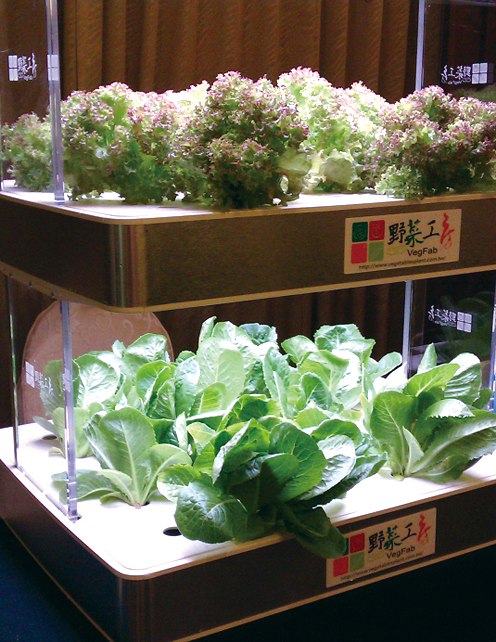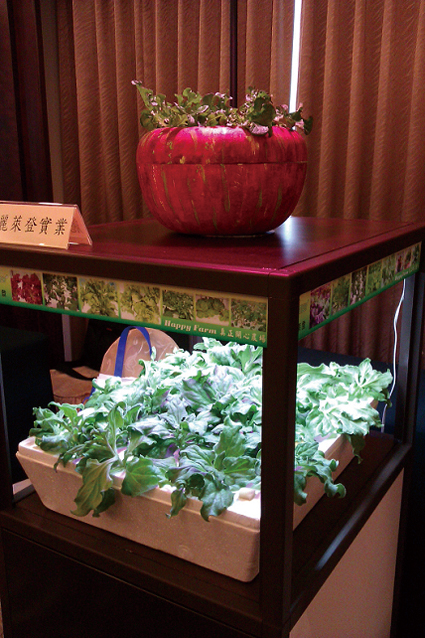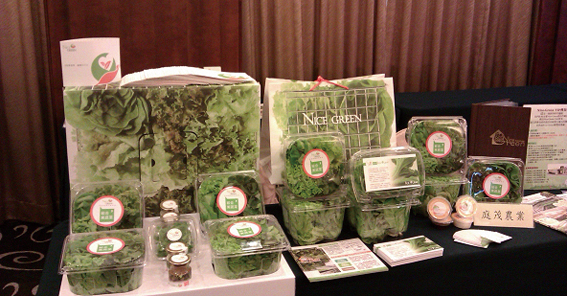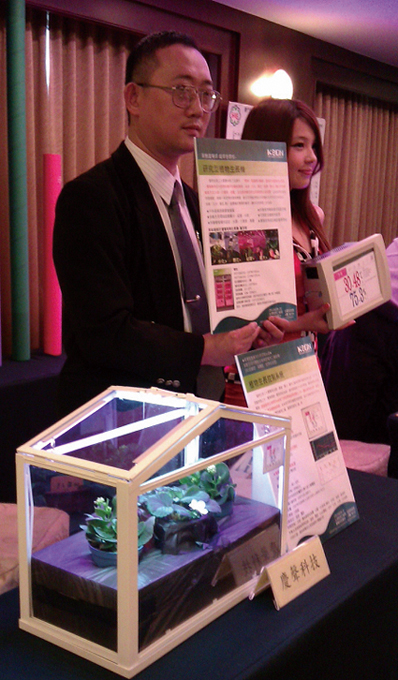Progress in Optoelectronic Technology Fuels Rise Of Plant Factories
For every period, there emerges a very powerful optoelectronic product. Right now, this is none other than the plant factory: PIDA
2013/10/04 | By Michelle HsuIn response to the recent upwelling of plant factories in Taiwan, the Photonics Industry & Technology Development Association (PIDA) organized several plant factory seminars this year, inviting industry operators to give their views and talk about their operations.
PIDA recognized the emergence of plant factories by including an exhibition on the subject at the Photonics Festival in Taiwan (also known as Taipei International Optoelectronics Week) in June last year. Returning this year, the exhibition has become Taiwan's largest plant factory show. The number of stalls increased by 60 over the previous year and big names in the industry attended to present their latest developments and display advanced plant factory components and equipment. The strong turnout underscores the advances made by plant factories in becoming a part of people's lives.
The Council of Agriculture (COA) organized a "COA Plant Factory Hall." Strongly backed by COA Chairman Chen Bao-ji, the exhibit featured "moveable style" plant factories showing mushroom cultivation techniques. The Metal Industries Research & Development Center arranged a "Smart Agricultural Production Hall" displaying the results of research on the application of LED and solar photovoltaic technology to aquaculture and animal husbandry.
Industry figures say that LED technology will become more pervasive in plant factories in the coming years, extending to cover the fields of agriculture, forestry, fisheries, and animal husbandry. These factories will help shape industrial development and create new opportunities for cooperation.
This year's Plant Factory Exhibition was held at the Taiwan World Trade Center (TWTC) Nangang Exhibition Hall on June 18-20. The event displayed advanced optoelectronic technology products and agricultural techniques, and brought together major plant factory makers and buyers from Taiwan and overseas, including from Japan, the United States, and China. Products on display included LED lights, hydroponic facilities, testing equipment, energy-saving and environmental control systems, and factory-grown produce.
LED as Mainstream Lighting
According to surveys conducted by the PIDA, the plant factory market is comprised mostly of two main fields: plant factory equipment and factory-grown produce. The global market for artificial lighting used in plant factories is expected grow at a compound annual rate of 27% over the next five years and could amount to US$1.2 billion this year.
PIDA Chairman Shih Ta-cheng remarked that for every period, there emerges a very powerful product in the optoelectronics industry, and at this stage the most powerful newly-emerging product is none other than the plant factory. Plant factories were actually conceived in Japan half a century ago, but factories at that time mostly made use of fluorescent lighting. The concept was slow to take off since more cost-effective lighting was not yet available.
The arrival of optoelectronic technology has created favorable conditions for the development of plant factories. In fact, plant factories can use any light source, but looking at current development status, plant factories using LED light sources seem to be the mainstream. This is mainly due to the ability to control lighting color and color temperature with LED lighting to suit the plant type. Long-life, low power consumption, high luminosity, smart digital control, and many other advantages are other advantages of LED lighting. The steady downward trend in pricing further makes LED lighting an attractive choice for plant factories.
Technology Evolution
"Technological progress will lead to a revolution in traditional farming techniques," said Chen Fong-yao, chairman of Chinese Plant Factory Association (CPFA), a sponsor of the Plant Factory Exhibition. "Plant factories use the most advanced farming technologies. They provide a clean environment for plants to grow and are making farming a popular new high-tech vocation," he added. Chen said that plant factories are a boon for organic farming and enable continuous vegetable and fruit growing, uninterrupted by climate changes. They simultaneously resolve the problem of food safety and food shortages around the world.
The CPFA was founded last year by alumni of National Taiwan University, which began offering graduate courses on plant factories two years ago. The association promotes plant factories at the household level, aiming to help families grow their own vegetables and fruits. "It's the best way to ensure food safety and make home a greener place," Chen said. To meet this end, the CPFA plans to partner with city and county farmer's associations to promote plant factories in residential communities.
Current Developments
"One of the great advantages of plant factories is the electronic control systems used to make photoperiodic adjustments to control flowering times, thus making it possible to predetermine harvest times and insulate growers from seasonal changes," remarked SOLIDLITE chairman Chen Hsing. "With lighting control systems we can grow summer fruit and vegetables in the winter or tropical crops in colder climates," he said.
Since poor lighting can lead to off-flavor results in factory-farmed produce, SOLIDLITE's electronic control systems have received considerable recognition by major international firms in recent years. SOLIDLITE has also made a patent-pending system for indoor growing strawberries and crested hami melons out of season.
Chen counts five major types of plant factory technologies and inputs: 1. Environmental control systems to regulate dust levels, temperature, humidity, air density, etc.; 2.
Mediated plant systems, such as soil or hydroponic farming systems; 3. Plant nutrients, such as organic fertilizers, liquid organic fertilizers, chemical fertilizers; 4. Artificial illumination such as fluorescent lamps, LED lamps, electrodeless lamps, CCFL lamps, and high-pressure sodium lamps; and 5. Warehousing and logistics such as cold storage and transport systems.
One of the major benefits of plant factories over traditional farms is the ability to dramatically increase growing areas by stacking plants: a practice that has earned these facilities the name of "vertical factories." Plant stacking also makes indoor farms an attractive option for households. Some companies even plan to convert shipping containers into mobile, solar-powered plant factories. At present Taiwan-made plant factories can stack plants to a height of about five or six layers, while Japanese plant factories may have stacks eleven or twelve layers high.
According to Shen Hsi-yan, general manager of Wang Yong Hydroponics, plant factories require a clean environment and therefore should be equipped with anti-dust and air sterilization devices at entrances. Climate conditions (such as temperature and humidity), light, cultivation systems and other control systems also play essential roles in determining the production capacity of a plant factory.
High-end plants
The Sanai plant factory of Arch Energy Company produces high-end medicinal plants, primarily ashitaba and jewel orchids (Anoectohilus). Company chairman Wu Kuang-chiau said that his plant factory uses TSMC modules for computer control systems regulating temperature, humidity, light and wind conditions in the plant. Wu believes that environmental control systems are Taiwan's strength in the plant factory sector, positioning local companies to provide turnkey services and win a place in the international market.
Arch Energy recently won a bid for a commercial and residential building project in Yantai City, Shandong Province, China. The project is the company's first foray into China's residential plant factory market. Wu is confident that global food shortages will create unlimited opportunities for high produce-yielding plant factories. will be unlimited."

Cost-cutting
VegFab Agricultural Technology, founded just over three years ago, has been focused on making factory-grown produce affordable. The company claims that its Yangmei plant factory is the world's largest, covering an area of approximately 1,800 square meters. The NT$1.4 billion facility is an entirely enclosed and environmentally controlled facility with stacked growing racks and LED lighting. The facility produces 900 tons of organic vegetables a year.
VegFab has been expanded rapidly, due mainly to its success in reducing cultivation costs and aiming its products at the budget end of the market. The Yangmei factory is cooled with the help of "wind walls" (with gaps) and large fans. The company estimates that this convection cooling approach can reduce its air conditioning costs by 70%.
Robotics also plays a role in keeping costs low at the Yangmei plant. The facility is equipped with robotic arms that can move planting trays: an operation that is typically performed four times during the growing cycle. The company estimates that automation of this work cuts its labor costs by about 40%.

Home Farms
The home-style hydroponic rack developed by Li Lai Den Industrial Co. comes in indoor and outdoor versions. The outdoor model can be placed on a balcony, in a garden, or on a roof. It can be used as a landscaping item, like a flowerpot or a window box, while also providing toxin-free, ready-to-eat fruit and vegetables. Its multifunctional plant cultivation racks are easy to assemble and disassemble. The racks have a stainless steel tube frame and high-quality net screens to extend usage life.
The indoor model will fit nicely in a corner of the living room, kitchen, basement or other room. Apart from their aesthetic appeal, indoor-grown plants can purify the indoor air. The cultivation racks have an optional waterproof foam board cabinet that can be customized to match the interior decoration.
Factory Fresh
Over the past four years, Nice Green Agricultural Biotechnology Co. has been developing plant factories that provide clean crop cultivation environments and can be optimized for a variety of crops.

The company's facilities strictly control environmental conditions in the factories, including temperature, humidity, light quality and intensity, and carbon dioxide concentration. This insulates crops from climatic harm and enables steady-state production throughout the year. Moreover, the company claims plant factories can increase crop yields and grow better quality crops that are free of pesticides and heavy metals, low in nitrates, and can be eaten raw without washing. This year, Nice Green launched a line of salad boxes with vegetables from plant factories. The produce integrates logistics and distribution and allows consumers to enjoy freshly grown vegetables.

King Son Instruments Tech Co. has 30 years of experience in environmental testing and simulation. In recent years, the company has applied its extensive IT experience to agricultural science and technology to develop an "outdoor climate research-grade planting mechanism," which it claims creates an indoor growing environment that is as close as possible to nature.
The company notes that the same species of plant grown in different environments will produce different results. For example, the same species of strawberry grown in different regions of Taiwan will grow at different speeds. In the case of strawberries, King Son's newly-developed 'outdoor climate research-grade planting mechanism models the environmental and climatic factors strawberries need at each stage in their growth. It then calculates the most suitable parameters for strawberry cultivation in order to optimize the environment for artificial strawberry growing.

